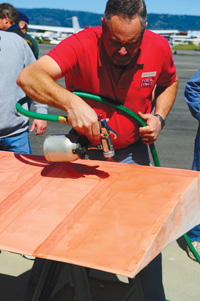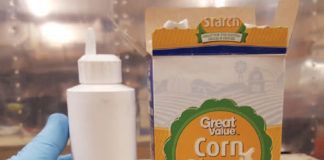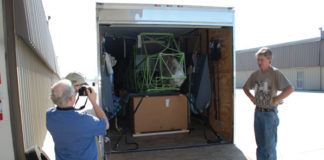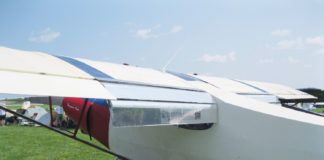
The steps involved in covering an airplane are essentially the same for all available fabric-covering systems until you are ready to apply the chemicals. Differences among the systems do exist, but they are somewhat minor until reaching this stage. Well review the steps we have discussed that must occur prior to spraying the chemical coats, and then we will begin this application process.
To begin with, the surface you are covering must be properly prepared. This is accomplished using an epoxy primer or an epoxy varnish following a thorough cleaning. After preparing the surface, it should then be carefully inspected for any defects. Remember that you will probably not have access to the inside of the surface for a number of years. After the inspection it is time to select the proper weight of fabric and then attach it to the structure using fabric cement.
Once the fabric is secured in place on a component part, it is then heat shrunk using a regular household iron. The iron is calibrated to the required temperature, and then the fabric is ironed until all areas have received the proper heat, ensuring that the fibers are adequately shrunk. With the Poly-Fiber covering system, the next step is to seal the fabric by brushing on a coat of Poly-Brush. This encapsulates all of the fibers and provides the necessary adhesion for all subsequent coats. This is an important step because the bond of this coat is essential for the remaining coats to properly adhere.
Next we attach the fabric to the wings and to all surfaces that provide lift. This important step prevents the fabric from ballooning up during flight due to the low pressure created on the top of the wing as a result of lift. The inspection rings and drain grommets are then cemented in place. Finally, several areas are covered, using tapes that are precut from the fabric into various widths. The most common width is 2 inches. This last step brings us to the spraying of the chemical coats.
The First Step
When you reach this stage of fabric covering most of the hard work is done. Many individuals are unsure whether they have the ability to spray paints and dopes on their airplane. Let me assure you that you can learn easily. It is not difficult to spray. This is particularly true when spraying the fabric-covering chemicals. They are more viscous and have fewer tendencies to run than regular enamels. This way you can learn the spraying techniques with a chemical that is easy to spray before you get to the color coats. Don’t be afraid to spray your own surfaces. With practice you will become proficient.
The first step in spraying is to select the proper spray outfit. Perhaps you already have a spray gun and compressor. If so, be sure it is a high-quality gun. Do not begin the spraying process with a cheap gun. Not using proper equipment will cause you untold grief as you spray. If you do not have a spray rig, I would suggest you consider purchasing a high-volume-low-pressure (HVLP) setup. These systems are easy to use, especially for those who have little or no spraying experience. They also plug right into a 110-volt outlet and come complete with everything you need. In addition, they will save you money by using fewer chemicals, because this type of outfit creates little overspray. In other words, the chemicals go on the fabric surface and not into the air.
Before you begin to spray, make sure you take the proper safety precautions. This involves purchasing a high-quality charcoal filtered face mask or a forced-air breathing system. If you will be painting your airplane with polyurethane paints, a forced-air breathing system is absolutely necessary. If you are not going to be using polyurethane paints, a good quality charcoal mask is sufficient. When mixing chemicals be sure to protect your eyes and skin. You should also protect your eyes and skin while spraying the various chemical coats.
Where to Spray?
A clean, well-ventilated area is necessary for spraying. Do not spray outside in direct sunlight. (The photos that accompany this story were taken at various hands-on clinics using non-flying components.) Try to find an area where you can construct a small spray booth using PVC pipe and clear plastic sheets. If this is not possible, find an area that is free from dust and dirt. Cover the floor if you want to keep it clean. Overspray will coat a floor over time. Good lighting is mandatory. Otherwise, you will miss areas, and create runs and sags, with the overall result being a poor finish. Be sure you have adequate ventilation and then begin to practice by spraying chemicals on pieces of cardboard, fabric panels, etc. A little practice will save you problems when you actually begin to spray your surface.
Another point to remember is that you should start out by spraying a small control surface. Don’t begin by spraying a wing. Start with a small surface so you can gain experience. You will be painting your entire airplane one piece at a time while it is apart. This is much easier than painting the entire airplane while it is assembled, which requires a lot more experience and practice.
Preparation
Now that you have practiced, you are ready to spray the first coat of Poly-Brush on a control surface. There are several considerations before you begin. First of all, the temperature of the area should be at least 60 to 65 F. Anything lower than 60 will impede the drying process. If the temperature is above 85 F, you must use a reducer that contains a retarder. If the temperature is above 95, or if the humidity is high, you will have to use a retarder to reduce the drying time. Again, do not spray in direct sunlight or if the wind is blowing.
Before you begin spraying you must be sure the surface of the structure is clean, which is best accomplished by passing a commercial tack rag over the area just prior to spraying. This slightly sticky rag is designed to pick up small pieces of lint, dirt, etc. Lightly pass the cloth over the surface. Do not rub the surface, though, because it could transfer unwanted chemicals to the area.
Next you must prepare the Poly-Brush for spraying. As you recall, we applied one coat of Poly-Brush after the fabric was shrunk using a brush. We will now spray a coat of Poly-Brush over the entire surface we are covering. Again, this is done after we have completely taped and prepared the structure we are going to spray. Poly-Brush must be properly thinned before applying. Use R65-75 Reducer if the ambient temperature is less than 85. If the temperature during the spraying operation will be higher than 85, then you must use R8500 Reducer. Thin the Poly-Brush using the formula of one part thinner to three parts of Poly-Brush. Mix it thoroughly and then pour it through a paint strainer. Use a 60×48-mesh paint strainer available from Poly-Fiber distributors. You can pour the mixture from the can through a strainer directly into your spray cup.
Play Misty for Me
You are now ready to spray. Start out by spraying a mist coat over the entire surface. This coat should put a fine layer of Poly-Brush over the area. It will not look wet when completed, because you have placed so little chemical over it that it does not create a uniform film. This mist coat will allow the next full coat to adhere to the surface properly. Trying to spray a thick coat on first will only cause runs and other imperfections. Wait about 15 minutes after the mist coat, and then spray a wet coat over the surface. This coat will be sprayed on heavier and will appear wet and shiny. Be careful not to spray too much chemical onto the surface, or runs and sags will result. If runs and sags occur, they should be immediately removed using reducer and a brush. Lightly brush out the runs before they dry.
Poly-Brush is normally tinted slightly to a pinkish color to allow you to apply it more easily. Still, you must have a good source of light when spraying. The Poly-Brush will appear to have a deeper pink color than the coat that was brushed on. As it dries it will become glossy.
Poly-Brush is also available without the pinkish tint. The untinted product is used where the backside of the fabric will be visible. An example of this would be on the fuselage of an open-cockpit airplane where you will actually see the backside of the fabric. You would not want the pinkish color showing in this area. The untinted Poly-Brush is a bit more difficult to apply.
Problem Areas
You may observe some problems while spraying. If the Poly-Brush sprays filaments that look like cotton candy, or if the surface dries rough, it has probably not been adequately thinned. Be sure you thin the mixture as directed. If the temperature is excessive, you may have to add BR-8600 Blush Retarder. This retarder simply slows the drying process so that the chemical has a chance to adhere to the surface before it begins to dry.
Of course, runs and sags may be a problem. Simply use a brush with thinner to brush out the run as soon as you discover it. Spray Poly-Brush over the area again. Do not try to sand out a run or sag at this point. Poly-Brush will not sand. Sanding will be done at a later stage of the process.
Pinholes may appear. These are tiny areas that have the appearance of a small hole. Insufficient filling of the fabric or tape weave during the brush coat may cause this problem. Spraying in direct sunlight can also cause pinholes. At this point the only way to cover a pinhole is to rub the area with a soft cloth and reducer. This will soften the Poly-Brush and force it into the unfilled weave. You must then spray the area again with thinned Poly-Brush with retarder added.
You may notice an orange peel appearance. This is often the result of using too much air pressure if you are using a pressure spray gun. It can also be caused by the coat being too thick.
If you notice some of the small edges of pinked tape lifting up, this is normal. The solvents sometimes cause small areas to release. This is easily resolved using a small iron calibrated to 225 F. Simply iron the edges down. They will then stay in place. Be careful not to leave the iron in one place too long.
Second Spray Coat
After allowing the first coat of Poly-Brush to dry thoroughly, you then should spray on a second coat. I recommend waiting a few hours between coats. If you spray on the first coat in the morning, wait until the afternoon to spray on the second coat. It should also be thinned according to our formula of one part thinner to three parts of Poly-Brush. Normally, one coat of Poly-Brush brushed on the surface followed by two spray coats of Poly-Brush will be adequate. You will then be ready to apply the Poly-Spray. We will discuss this important step in next months installment of the series.













